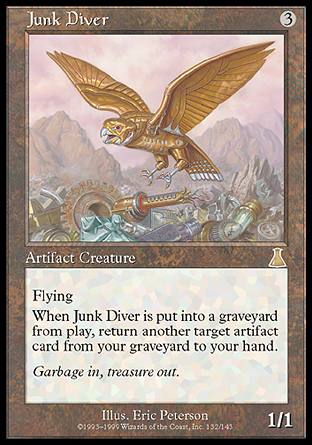by Zack Alvarado
- Junk Diver. (c) 2013 Wizards of the Coast.
Across the web, you can locate many different columns and articles filled with endless salvos of financial advice regarding Magic the Gathering investment ploys and tactics. Amongst all of the fluff, however, is very little – if any – advice about what not do to and how to avoid being burned by bad investment maneuvers. Surely I could put my trade-formula on paper for you to take note of and apply, but I’ve no interest in sharing my homework (at least not for free). However, I am much more willing to share the investment practices that I avoid making; as opposed to the trade-secrets that have continued to feed me. Beginning with this week, I will write a 3 part mini-series about avoiding bad trade habits.
- Bad Tactic to Avoid #1: Buying bulk lots (Today)
- Bad Tactic to Avoid #2: Buying chase foils (3/25/13)
- Bad Tactic to Avoid #3: Trading non-standard cards for standard cards (4/1/13)
Let’s jump right into things and discuss why you should avoid the first bad tactic of buying bulk lots. In general, bulk lots are a great starting point for new players – but that’s where the most value exists: amongst players without large pools of cards to select from; players who’ve been collecting for years tend to have a versatile assortment of readily playable cards, with no need to purchase a bulk lot. Assume I purchase a lot of 200,000 cards for $5,000.00, and want to resell them; the average LGS’s boxes of singles are priced: $0.10 per common, and $0.25-0.50 per uncommon; if I bought 200,000 cards for $5,000.00, I would pay $0.025 per card. Now, if I could sell each card for $.05 (half of the average common price) then I would make $10,000.00 – a return on investment of 200%! But wait, that’s a horrible plan; even if I stand to double my money, I have to consider the amount of time and energy I would need to spend in order to look through the cards – as I assume there are some worth $1-$5 in the bunch, and want to ensure I’m not losing any money when selling them for 0.05 each. Moreso than the effort I must exert to rummage through a fifth of a million cards, I have to worry about the amount of time it will take me to sell these cards; if I manage to sell 10 cards to each person who purchases from me, I still need a total of 20,000 sales before they are all gone – seeing the bigger picture? Good, because my time is valuable, and I hope that you believe yours is as well.
It’s my experience in the long run, that buying bulk lots is a bad investment habit; this doesn’t mean that money can’t be made from bulk lots, but rather that re-selling bulk lots is a bad plan for profit. If you find yourself sitting on plenty of spare commons and uncommons that you’ve multiple playsets of, or never intend on using in decks, then it’s time to make some extra gas and lunch money – here’s how (ok fine, I’m sharing a small personal tactic): organize your extras by rarity first (commons & uncommon), then organize them by color, and then finally organize them by format (vintage, legacy, modern, standard); buy a few 500 count and 1000 count boxes; fill a box of cards with uniform rarity, color, and format – then mark it for sale (1000 Standard Red Commons for $20). I charge $10 per 500 commons, and $10 per 100 uncommons. These bulk boxes bring in steady money for me, and clear my storage space – I can’t complain one bit.
If you catch the scent of a bad investment model, don’t bite down; instead, evaluate how to apply relative business principles within your frame of access, in order to maximize inventory turnover and ultimately, to ‘freshen the scent’ for customers. Well how exactly do you go about ‘freshening’ the appeal of bulk lots? Simple – don’t pick out every card with relative value: nobody wants to purchase bulk Grizzly Bears and Stone Rain with assorted basic core land. I’m not advising that you spice up your bulk boxes with Sensei’s Divining Top or Remand, but, small things like Mana Leak, Rampant Growth, Shock, Terror, and Holy Day are dirt cheap and appealing to casual players. For the record, ‘casual player’ is not synonymous for ‘drooling troglodyte’ – if you want somebody to bite on your offer, make it smell better: stacking garbage onto a garbage heap adds zero definition and increases the stench. This will conclude my weekly entry for MTGPrice.com. I thank you for reading, and hope that you’ll return next week to check out the 2nd article of this series!
Money Ramp Weekly Tip:
[Stock up on Kessig Wolf Runs, these things are flying off of shelves!]
Until next time,
Zack R Alvarado
zackalvarado@gmail.com
Twitter: Rh1zzualo
